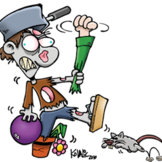Hey,
So I'm currently working on my first serious project. It's basically a rogue-like combat game that focuses on melee. I want the combat to be a blend of Crawl and Hyper Light Drifter. Anyways, I've been thinking about how to structure the game and cannot organize my ideas. Earlier, I wanted to create a health system for my player. Instead of just adding one to my 'PlayerController' however, I made a generic one with variables and methods that would allow for generic data storage. You'd specify a max health, and then use a method to inflict damage whenever needed. There was also a method to check if the entity died.
I'm not sure if I can structure my whole project this way. So far my only other script is the one controlling player movement/attacks. I'm using Unity, so component-based design is a pretty big thing, Now I have to implement things like an XP system, a generic control for monster AI, and a template to define weapons. How should I approach all this code? How should I structure it? I took a look at this but still don't quite understand what it means.
The entire time I've been making games, I've just been doing my thing. I found out with my last decently sized project that just writing code is not a good idea. Can someone introduce me to some game design/structure principles?
Thanks.








